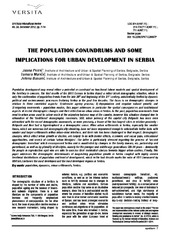Приказ основних података о документу
The population conundrums and some implications for urban development in Serbia
| dc.creator | Petrić, Jasna | |
| dc.creator | Maričić, Tamara | |
| dc.creator | Basarić, Jelena | |
| dc.date.accessioned | 2018-12-26T10:57:51Z | |
| dc.date.available | 2018-12-26T10:57:51Z | |
| dc.date.issued | 2012 | |
| dc.identifier.issn | 1450-569X | |
| dc.identifier.uri | https://raumplan.iaus.ac.rs/handle/123456789/216 | |
| dc.description.abstract | Population development may reveal either a potential or constraint on functional labour markets and spatial development of the territory in concern. The first results of the 2011 Census in Serbia depict a rather bleak demographic situation, which is only the continuation of population trends from the late 20th and beginning of the 21st century, substantially fuelled by dynamic political and socioeconomic processes featuring Serbia in the past few decades. The focus is on demographic changes in relation to three correlated aspects: 1) intensive ageing process; 2) depopulation and negative natural growth; and 3) migratory movements - population exodus. This paper addresses in particular the spatial consequences and institutional aspects of recent demographic changes and their reflection on urban areas in Serbia. In the past, population movements from rural to urban areas used to colour much of the migratory balance map of the country, however this situation changed due to exhaustion of the 'traditional' demographic reservoirs. Still, urban primacy of the capital city Belgrade has been even intensified with the recent demographic movements, or more precisely, a tissue of the two largest cities in relative proximity - Belgrade and Novi Sad is hypertrophied in a demographic sense. Other urban settlements in Serbia, especially the smaller towns, which are numerous but demographically shrinking, have not been empowered enough to substantiate better links with smaller and larger settlements within urban-rural interface, and their role has been challenged in that respect. Demographic changes, which affect urban growth or decline, are largely to do with border effects, economic and social gaps, educational opportunities, and search of certain 'urban lifestyles'. The latter is particularly stressed regarding the process of 'second demographic transition' which encompassed Serbia and is manifested by changes in the family domain, viz. partnership and parenthood, as well as by plurality of lifestyles, namely for the younger and middle-age generations (20-34 years - dominantly the people in reproductive age) who are able to exercise their residential choices towards bigger urban centres. Finally, this paper addresses the demographic determinants of languishing population growth in Serbia coupled with highly uneven territorial distributions of population and level of development, which in the last decade marks the ratio of 10:1 (measured by GDP/inh.) between the most developed and the least developed regions in Serbia. | en |
| dc.publisher | Institute of Architecture, Urban & Spatial Planning of Serbia | |
| dc.relation | info:eu-repo/grantAgreement/MESTD/Integrated and Interdisciplinary Research (IIR or III)/47014/RS// | |
| dc.rights | openAccess | |
| dc.rights.uri | https://creativecommons.org/licenses/by-nc-nd/4.0/ | |
| dc.source | Spatium | |
| dc.subject | population | en |
| dc.subject | dynamics | en |
| dc.subject | urban settlements | en |
| dc.subject | Serbia | en |
| dc.title | The population conundrums and some implications for urban development in Serbia | en |
| dc.type | article | |
| dc.rights.license | BY-NC-ND | |
| dcterms.abstract | Петрић, Јасна; Маричић, Тамара; Басарић, Јелена; | |
| dc.citation.issue | 28 | |
| dc.citation.spage | 7 | |
| dc.citation.epage | 14 | |
| dc.citation.other | (28): 7-14 | |
| dc.citation.rank | M24 | |
| dc.identifier.doi | 10.2298/SPAT1228007P | |
| dc.identifier.scopus | 2-s2.0-84879719996 | |
| dc.identifier.fulltext | https://raumplan.iaus.ac.rs//bitstream/id/1563/213.pdf | |
| dc.type.version | publishedVersion |

